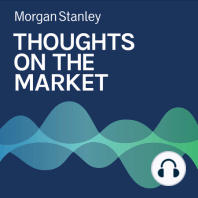3 min listen
Mike Wilson: The Risk of a Credit Crunch
ratings:
Length:
4 minutes
Released:
Mar 20, 2023
Format:
Podcast episode
Description
As markets look to recent bank failures, how are valuations for both stocks and bonds likely to change with this risk to growth?----- Transcript -----Welcome to Thoughts on the Market. I'm Mike Wilson, Chief Investment Officer and Chief U.S. Equity Strategist for Morgan Stanley. Along with my colleagues, bringing you a variety of perspectives, I'll be talking about the latest trends in the financial marketplace. It's Monday, March 20th at 11 a.m. in New York. So let's get after it. Over the past few weeks, the markets have fixated on the rapid failure of two major banks that, up until very recently, have been viewed as safe depository institutions. The reason for their demise is crystal clear in hindsight, and not that surprising when you see the interest rate risk these banks were taking with their deposits, and the fact that the Fed has raised rates by five percentage points in the past year. The uninsured deposit backstop put in place by the Fed and FDIC will help to alleviate further major bank runs, but it won't stop the already tight lending standards across the banking industry from getting even tighter. It also won't prevent the cost of deposits from rising, thereby pressuring net interest margins. In short, the risk of a credit crunch has increased materially. Bond markets have exhibited volatility around these developments as market participants realize the ramifications of tighter credit. The yield curve has steepened by 60 basis points in a matter of days, something seen only a few times in history and usually the bond market's way of saying recession risk is now more elevated. An inversion of the curve typically signals a recession within 12 months, but the real risk starts when it re-steepens from the trough. Meanwhile, the European Central Bank decided to raise rates by 50 basis points last week, despite Europe's own banking issues and sluggish economy. The German bund curve seemed to disagree with that decision and steepened by 50 basis points, signaling greater recession risk like in the U.S. If growth is likely to slow further from the incremental tightening in the U.S. banking system and the bond market seems to be supporting that conclusion, why on earth did U.S. stocks rally last week? We think it had to do with the growing view that the Fed and FDIC bail out of depositors is a form of quantitative easing and provides a catalyst for stocks to go higher. While the $300 billion increase in Fed balance sheet reserves last week does re liquefy the banking system, it does little in terms of creating new money that can flow into the economy or markets, at least beyond a brief period of, say, a day or a few weeks. Secondarily, the fact that the Fed is lending, not buying, also matters. If a bank borrows from the Fed, it's expanding its own balance sheet, making leverage ratios more binding. When the Fed buys a security outright, the seller of that security has more balance sheet space for renewed expansion. That is not the case in this situation, in our view. As of Wednesday last week, the Fed was lending depository institutions $300 billion more than it was the prior week. Half was primary credit through the discount window, which is often viewed as temporary borrowing and unlikely to translate into new credit creation for the economy. The other half was a loan to the bridge the FDIC created for the failed banks. It's unlikely that any of these reserves will transmit to the economy as bank deposits normally do. Instead, we believe the overall velocity of money in the banking system is likely to fall sharply and more than offset any increase in reserves, especially given the temporary emergency nature of these funds. Over the past month, the correlation between stocks and bonds has reversed and is now negative. In other words, stocks go down when rates fall now and vice versa. This is in sharp contrast to most of the past year when stocks are more worried about inflation, the Fed's reaction to it and rates going
Released:
Mar 20, 2023
Format:
Podcast episode
Titles in the series (100)
Andrew Sheets: For Markets, Signs, Signs, Everywhere Signs by Thoughts on the Market
